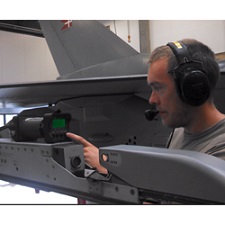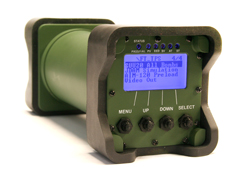Field and Flightline Testing of MIL-STD-1760 SystemsFrom Test Connections Newsletter - March 2015
MIL-STD-1760 defines the electrical interface between the aircraft and the Carriage Stores as well as the mechanical and communication protocol aspects of the interface.
 | The intent of MIL-STD-1760 (also known as just "1760") was to simplify the integration of new weapons onto existing platforms. Prior to the introduction of 1760, the integration cost of a new weapon system was over $100 million dollars (in 1980 dollars). With 1760, integration costs shrank to under $25 million which was a significant improvement.
As with all good inventions, there’s always a "but" and 1760 was no exception. Most field and flight-line test sets for armament were deployed over three decades ago and as such, were not suitable to test the "smart" interface of MIL-STD-1760. And unlike legacy systems, the aircraft is expecting to have a carriage store present in order to keep the interface active. Immediately after powering up the 1760 interface, the aircraft sends a MIL-STD-1553 transmission that can be translated to "who’s out there". |
The aircraft is expecting an answer within 150 mSec and this response needs to include the identification of the Carriage Store or at least a message that says "I’m busy". In case of the "busy" message, the aircraft expects the identification response within 500 mSec of power up. If there’s no response from the carriage store, the aircraft shuts down the interface and it is no longer powered or operating.
Legacy field and flight-line test sets cannot communicate with the aircraft as they do not include the ability to test a 1760 interface. As a result, they can only perform some limited testing of the interface during the first 150 mSec after power up. However, since they can’t even respond with an "I’m busy" answer, the interface will be shut down 150 mSec after power is applied and from that point forward, the test set is testing a dormant interface. Since one of the main functions of flight-line armament test sets is to check for stray voltage and functionality, it is clear that neither can be achieved unless the aircraft "believes" that there’s a real 1760 carriage store present and active.
In order to effectively test the interface, the test set not only needs to support the MIL-STD-1760 interface but it also needs to be able to identify itself as a real carriage store that will be recognized by the aircraft as part of its standard configuration. Since this is not easily achieved, many users revert to the use of the real carriage store when testing is needed although using a real carriage store as a test set has its complications too. Stores such as JDAM cannot just be connected to the interface. Because the store’s Inertial Measurement Unit (IMU) needs to be aligned, the store will need to move before it can be aligned prior to testing the interface. This means that the aircraft needs to be taxied around the base until such alignment is achieved which also means that a pilot is now needed to run the test. Obviously, having a pilot taxi the aircraft around the air base to test the 1760 interface is not a preferred method although it is being used occasionally. Alternatively, maintainers have attempted to use other tools, such as a ruggedized laptop with a MIL-STD-1553 interface configured as a weapon. However, this solution is also inadequate since it does not support the testing of power, analog, or discrete signals associated with the 1760 interface.
Full featured and complete testing of the 1760 interface is key to ensuring mission readiness. Recognizing this need for a next generation flight-line test solution, Marvin Test Solutions (MTS) developed the MTS-3060 SmartCan. As a universal flight line armament test set the SmartCan is capable of testing all legacy and "smart" interfaces used on military aircraft.
Most military aircraft today are capable of carrying JDAM and for that reason, MTS elected to implement JDAM support with the SmartCan. Upon power up, the SmartCan will identify itself as a JDAM and test the entire interface while the aircraft is communicating with the "JDAM". Additionally, since some wing stations (such as the wingtip) cannot be used with JDAM, MTS also implemented support for testing the AIM-120 AMRAAM interface. With the SmartCan, the aircraft does not need to be moved anywhere and the 1760 interface can be tested thoroughly without moving the aircraft.
The compact and handheld MTS-3060 SmartCan™ operates from four commercial AA batteries and weighs less than 2 Kg, making it ideal for flight-line test applications. With its full-featured MIL-STD-1553 interface, the SmartCan can support the testing of virtually any "smart weapon" interface including JDAM and AIM-120. Additionally, it can load / test AC and DC power lines, provide video for testing the 1760’s analog signals, and check for the functionality and presence of stray voltage on the Release Consent line. |  |
|